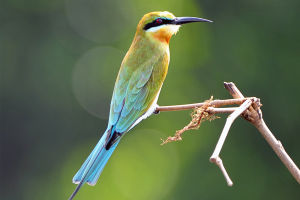The Blue Jay, a bird that effortlessly captures attention with its striking blue plumage and bold presence, is a common yet fascinating resident of North American woodlands and backyards.
Known for its intelligence and complex social behavior, this bird is not just a backyard beauty but also a source of endless intrigue and amusement for bird enthusiasts.
The Life and Habits of Blue Jays
1. Appearance and Identification
Blue Jays are medium-sized birds, measuring about 9 to 12 inches in length with a wingspan of 13 to 17 inches. They are easily recognized by their vibrant blue coloring on the upper body and wings, contrasted by white or light gray underparts.
The bird's head is adorned with a pronounced crest that can be raised or lowered depending on its mood, and a black necklace-like band across the throat and chest adds to its striking appearance. The blue color is not due to pigmentation but is actually a result of light refraction in the structure of their feathers, creating a stunning optical illusion.
2. Habitat and Range
Blue Jays are commonly found throughout eastern and central North America, ranging from southern Canada to the Gulf of Mexico. They are adaptable birds, inhabiting a variety of environments, including forests, parks, and suburban areas. Blue Jays are particularly fond of oak trees, which provide both food in the form of acorns and ample nesting opportunities.
3. Diet and Feeding Behavior
These birds are omnivorous, with a diet that includes nuts, seeds, fruits, insects, and occasionally small vertebrates. Blue Jays are particularly known for their love of acorns, which they often cache for later consumption. This behavior has played a significant role in the dispersal of oak trees, as many of the acorns they bury are never retrieved, leading to new tree growth.
Funny and Fascinating Facts About Blue Jays
1. Mimicry Masters
One of the most entertaining aspects of Blue Jay's behavior is their ability to mimic the calls of other birds, particularly hawks. This mimicry may serve several purposes, such as warning other jays of a hawk's presence or confusing potential predators. Their vocal range is extensive, and their calls include a variety of sounds, from clicks and whirrs to the iconic “jay-jay” call.
2. Mysterious Migration Patterns
While many Blue Jays are year-round residents, some populations exhibit migratory behavior. Each fall, thousands of Blue Jays migrate in flocks along the Great Lakes and Atlantic coasts. Interestingly, the reasons behind their migration are not well understood. Some jays migrate one year but not the next, and age does not seem to be a factor in whether a bird migrates or not.
3. Tool Use and Problem-Solving
In captivity, Blue Jays have demonstrated remarkable problem-solving abilities and tool use. They have been observed using strips of newspaper to reach food, showcasing their intelligence and adaptability. This behavior highlights their cognitive abilities, which are comparable to those of other intelligent bird species, such as crows and ravens.
4. Social Structure and Behavior
Blue Jays are highly social birds, often seen traveling in family groups or small flocks. They exhibit complex social behaviors and communicate with each other through a combination of vocalizations and body language. During breeding season, they are known to form monogamous pairs and are highly territorial, often engaging in noisy displays to defend their nesting area.
5. Feather Illusions
Despite their vibrant blue appearance, Blue Jay feathers actually contain brown melanin. The blue color is a result of light scattering, similar to the way the sky appears blue. This structural coloration is a fascinating example of how nature uses physics to create brilliant displays without relying on pigments.
6. Aged Survivors
The oldest known Blue Jay lived nearly 27 years, showcasing the longevity these birds can achieve under the right conditions. In the wild, they typically live around 7 years, though they face numerous threats, including predation by hawks, owls, and snakes, as well as habitat loss.
Blue Jays are more than just a common backyard bird; they are intelligent, complex creatures with a range of fascinating behaviors. Their ability to mimic, problem-solve, and adapt to different environments makes them a captivating subject for bird watchers and nature enthusiasts alike.
Lykkers, as we continue to learn more about these remarkable birds, they remind us of the beauty and complexity of the natural world and the importance of preserving the habitats they depend on.


